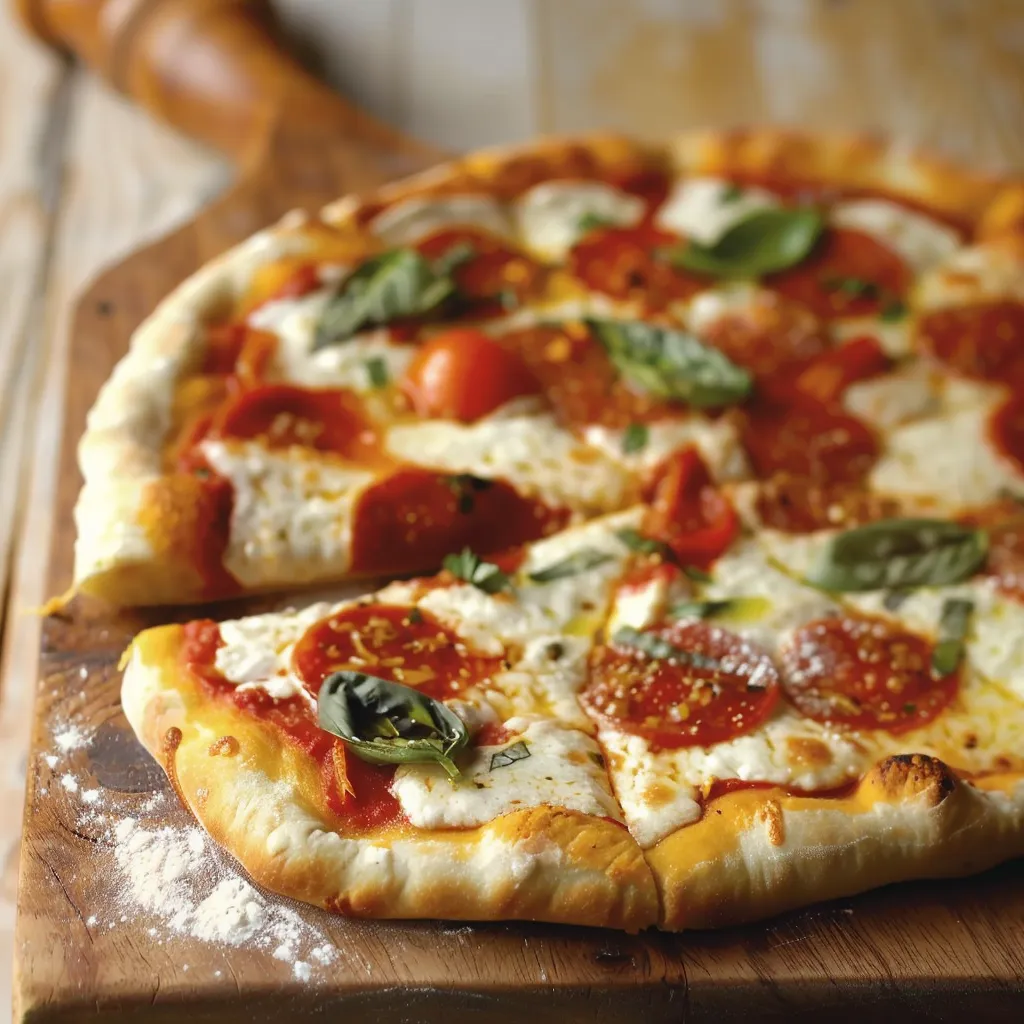 Pin it
Pin it
This simple Bobby Flay pizza base formula makes the ideal canvas for amazing homemade pies with that sought-after crispy-yet-chewy bite. Through countless pizza evening trials, this method has consistently given me restaurant-level results right at home.
I stumbled on this formula during a cooking binge when I was trying to nail homemade pizza. After many letdowns with other doughs, this one quickly turned into our Friday ritual, with my children now turning down delivery in favor of what we make ourselves.
What You'll Need
- Warm water: roughly 110°F lets yeast wake up without damaging it
- Quick-rise yeast: gives steady fermentation and shortens waiting
- Honey: brings light sweetness and nourishes yeast for better growth
- Fine granulated sugar: teams with honey to jump-start yeast
- All-purpose bread flour: gives the right chewy feel with good gluten growth
- Flaky sea salt: boosts flavor and helps manage how fast things ferment
- Garlic powder: adds a mild savory touch throughout the base
- Extra virgin olive oil: brings depth and helps create that wanted crisp outside
Making It Happen
- Get Everything Ready:
- Have all items measured before you start so they're set when you need them. Water temp matters here about 110°F should feel like warm bath water on your wrist. Too warm will harm the yeast, too cool will drag out activation. Having stuff ready stops goofs during the key rising stage.
- Wake Up The Yeast:
- Mix warm water, honey, and sugar in a big bowl until they dissolve. Scatter yeast across the top evenly and let it sit untouched for 5-10 minutes. Watch for foam and bubbles to form showing active yeast. This visual check means your dough will puff up right. No bubbles after 10 minutes? Your yeast might be bad so start fresh.
- Combine Dry Stuff:
- In another bowl, mix 3 1/2 cups of bread flour, sea salt, and garlic powder until blended well. Mixing spreads the salt and garlic powder all through the flour. Keep the leftover flour aside for tweaks while kneading since dampness changes how flour soaks up liquid.
- Form The Dough:
- Add olive oil to the bubbly yeast mix, then slowly pour in the dry stuff about a cup at a time. Stir after each bit until rough dough forms. This slow adding stops flour clumps and makes sure everything gets wet evenly. The dough should pull from the bowl sides but still feel a bit sticky.
- Work The Dough:
- Dump dough onto a lightly floured counter and push it around for 5-7 minutes with your palm. Good kneading builds gluten which makes that perfect chewy texture. You'll feel it getting smoother and more stretchy as you work. It's ready when it bounces back after a light finger poke.
- Let It Grow:
- Shape kneaded dough into a nice ball and put it in a bowl with a touch of olive oil. Cover fully with plastic or a damp cloth. Let it sit in a warm spot with no drafts for about an hour until it's twice as big. The best temp for rising is about 75-80°F. Look for noticeably bigger, puffy dough that's doubled in size.
- Push Down And Form:
- Press your fist gently into the middle of the puffy dough to let extra gas out. This stops big air pockets in your final crust. Cut the dough into two equal parts using a scraper or knife. Form each part into a tight ball by tucking edges under and turning in your hands until the top looks smooth.
- Rise Again:
- Put dough balls on a lightly floured spot, cover with plastic or a clean towel, and let them puff up again for 30 minutes. This second rise makes flavor better and helps the dough stretch easier. The dough should get puffy again but won't necessarily double.
- Stretch It Out:
- On a floured spot, push each dough ball into a flat circle using your fingertips, working from middle to edge. Then pick up the disc and gently pull it with your knuckles, turning as you go to keep thickness even. Aim for about 12 inches across with slightly thicker edges to make a natural rim.
- Cook The Dough:
- Heat your oven to 475°F with a pizza stone or baking sheet inside for at least half an hour. Move shaped dough to a pizza peel dusted with cornmeal or flour. Cook for 5-7 minutes until firm but not brown. This makes a barrier that keeps toppings from making the crust soggy.
 Pin it
Pin it
This dough has totally changed my home pizza game. The honey might look weird in the list, but it gives the crust a subtle depth that makes everyone ask what my trick is. My best memory with this dough was during a neighborhood blackout when we fired up the grill and made pizzas outdoors. The light smoky flavor from grilling plus this dough made an amazing meal that brought all the neighbors to our yard.
Keeping It Fresh
After the first rise, you can keep this dough in the fridge up to three days in an airtight container or plastic wrap. The flavor actually gets better overnight in the fridge as the yeast slowly works, creating richer taste notes. When you're ready to use cold dough, take it out about an hour before stretching so it can warm up. For longer keeping, freeze the dough balls right after first rise by wrapping them tight in plastic and putting them in freezer bags. Frozen dough stays good for about three months. Thaw overnight in the fridge, then let it sit at room temp for about two hours before stretching.
Great Combos
This easy-going dough works great with both classic and creative toppings. For true Neapolitan style, top the par-baked crust with basic San Marzano tomato sauce, fresh mozzarella, and basil. For a white pizza, brush the par-baked crust with olive oil, sprinkle with chopped garlic, and add ricotta, mozzarella, and Parmesan cheeses. The sturdy texture even handles heavy toppings like Bobby Flays favorite mix of sweet cooked onions, gorgonzola, and arugula added after baking. For a full meal, serve with a simple green salad tossed with lemon and olive oil to cut through the pizza's richness.
Fixing Common Issues
If your dough feels too sticky while kneading, add flour one spoon at a time until it feels right. If it seems too dry and breaks apart, wet your hands and keep kneading to add moisture. Having trouble with shaping? Try letting the dough rest for 5 minutes if it keeps shrinking back when stretched. This helps the gluten relax. If your baked crust isn't crispy enough, your oven might not be hot enough. Check with an oven thermometer and try cooking the bare crust 2-3 minutes longer. For the best crispy bottom, try getting a pizza stone or steel that holds high heat.
 Pin it
Pin it
Getting good at this pizza dough means your homemade pizza nights will beat takeout every time. Have fun trying different flavors and methods to create your own signature pies!
Frequently Asked Questions
- → What’s the ideal water temperature for the yeast?
The water should feel warm, about 110°F. It’s warm enough to activate the yeast without damaging it.
- → Is kneading by hand necessary?
No, you can use a stand mixer with a dough hook to get the job done. It’s quicker, but hand-kneading is totally fine too.
- → Why is kneading important?
Kneading builds gluten, which gives the dough its elasticity and structure, making it rise better and bake well.
- → Should the crust be baked before adding toppings?
Yes, slip it into a 475°F oven for about 5-7 minutes before toppings. This helps the crust stay crisp and avoids sogginess.
- → How do I keep extra dough fresh?
Refrigerate leftover dough for up to 3 days or freeze for longer. Use plastic wrap or an airtight container to prevent it from drying out.
- → Can I switch to whole wheat flour?
Absolutely, but keep in mind the texture might turn out denser. A mix of whole wheat and all-purpose flour can give you the best of both worlds.
